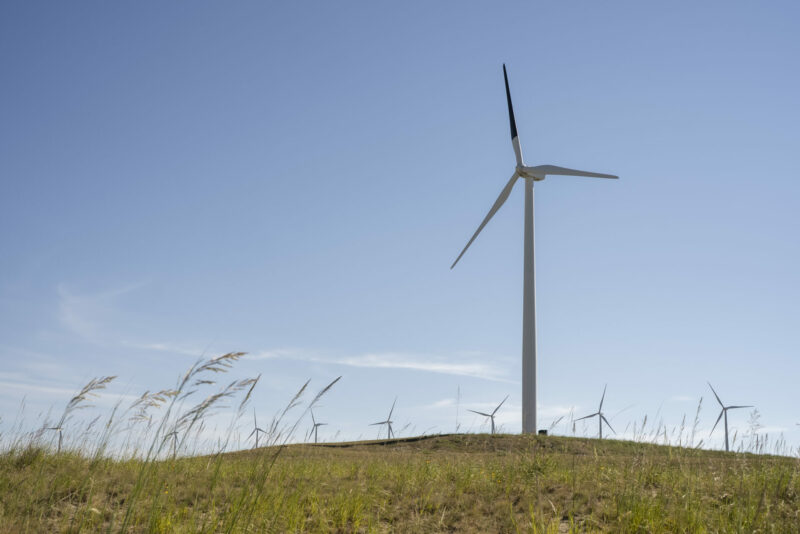
Photo Credit: PacifiCorp
Can Painting One Blade Black Help Birds Avoid Wind Turbines?
Since April 2023, a team in Glenrock, Wyoming has been hard at work painting one blade black on 36 different wind turbines to evaluate the effects of this strategy to reduce risks to birds flying near the wind turbines. PacifiCorp, the Renewable Energy Wildlife Institute (REWI), the United States Geological Survey (USGS), and other research partners are moving forward with this highly anticipated and ambitious study, along with others in a public-private partnership that includes the U.S. Fish and Wildlife (USFW), U.S. Department of Energy (DOE), Oregon State University, Invenergy, and NextEra Energy.
The study focuses on how the painted blades affect fatality rates for eagles, diurnal non-eagle birds, and bats. Experts hypothesize that both eagles and diurnal non-eagle birds can perceive painted blades, resulting in higher turbine avoidance.
The team has painted 28 blades so far and will complete the remaining eight in 2024.
“This is an unprecedented partnership of scientists, federal regulators and wildlife managers, a non-governmental organization, academia, and other utility companies working together to find solutions to reducing impacts to birds,” says Will Shallenburger, vice president of renewable resources for PacifiCorp.
Several renewable energy companies have demonstrated their support for the study through the Renewable Energy Wildlife Research Fund (REWRF). REWRF is an industry-led initiative that advances scientific research on solutions to mitigate solar and wind-wildlife impacts as accelerating renewable energy meets clean energy demand. “Industry members formed REWRF to combine our resources and advance our understanding of how renewable energy projects impact wildlife. We are pleased to support the Painted Wind Blade Study effort and look forward to the results of this study, from which we hope to gain insights into how the industry can ultimately eliminate any adverse impacts,” according to Ray Kelly, Environmental Senior Director at Clearway Energy Group and former REWRF Chair.
Recent research in Norway documented a nearly 72% decline in turbine blade-related bird collisions as a result of painting one turbine blade in black. Painting blades is thought to visually disrupt what otherwise may appear to the bird as a uniform airspace, making the turbine more visible and helping trigger avoidance behavior.
Bats have different visual and auditory perceptions of their surroundings while flying, so the study incorporates a second hypothesis that bats do not perceive painted blades and there would be no change in bat collision fatalities at turbines with painted blades.
“The research team, led by the USGS, has produced a very innovative approach, allowing them to accurately estimate the benefits of painted turbine blades in the hope of minimizing impacts on eagles and other diurnal birds. PacifiCorp’s facility allows us to study this interaction at an impressive scale, with 36 painted turbines and even more control turbines to include in the experiment. We’re honored to be part of the team and excited to see the results as the study progresses,” said Shilo Felton, senior scientist at REWI.
“If proven effective, the manipulation could reduce bird fatalities at wind facilities that would be realized over decades, with minimal maintenance, infrastructure or other constraints required of current technologies,” said Shallenburger.
There has been widespread support in the U.S., as evidenced by this study by PacifiCorp and its partners, to replicate the Norway study with more treated turbines to confirm if similar results can be reached at other wind energy sites. This study could be critical in shining a light on one strategy to avoid, minimize, or mitigate negative impacts on birds and other wildlife. With accelerating climate change, it becomes ever clearer that renewable energy is critical to reducing emissions, lowering global temperatures, and protecting the ecosystems that birds require to survive.
Read PacifiCorp’s article on the Painted Blade Study.